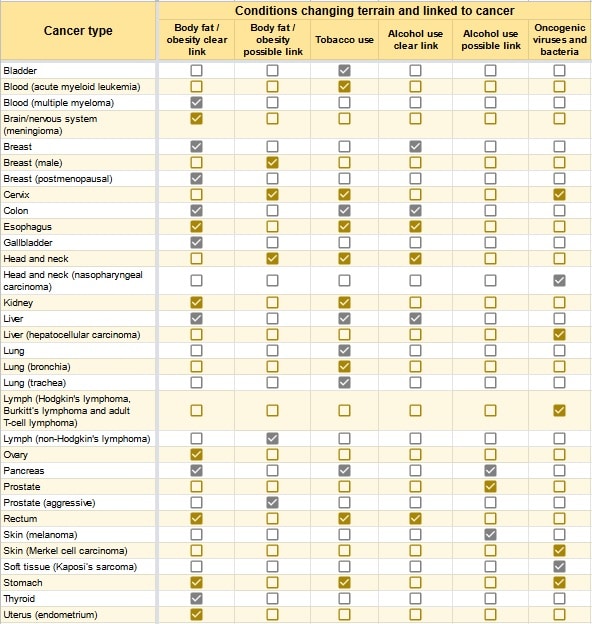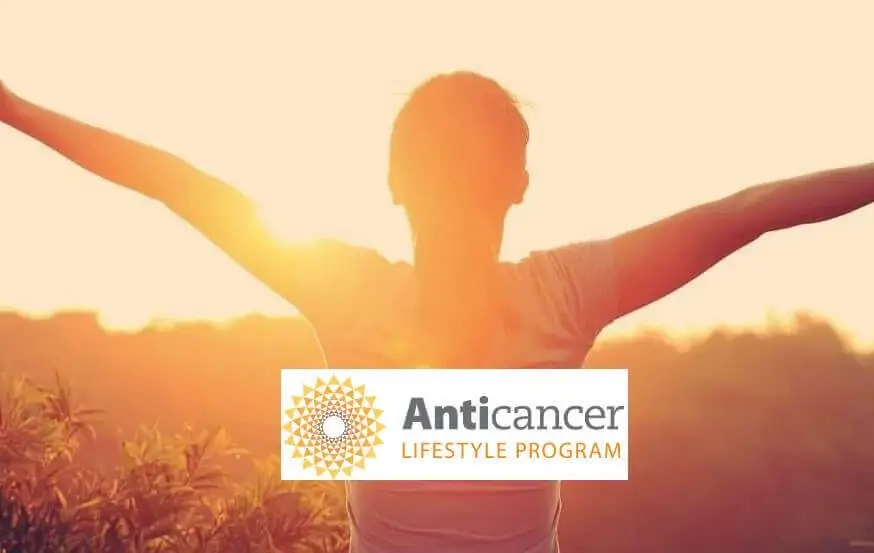It’s so important to resist blaming yourself if you get cancer: Our message is always, “Begin now. Don’t look back. We have no idea what caused your cancer . . . But we do know that there are things you can do differently that will make a radical difference in how you feel.”
Meg Cadoux Hirshberg, CancerChoices advisor and founder of Anticancer Lifestyle Program
A letter from Laura
Making lifestyle choices beyond the 7 Lifestyle Practices includes keeping your weight at a healthy level, staying away from tobacco smoke, limiting alcohol intake, and limiting sun exposure.
A letter from Laura
You may be nodding your head right now saying “I know, I know—being overweight, smoking, and too much alcohol are not good for me and changing this could save my life and not changing this may shorten my life and make me feel bad in the meantime. But . . . “
We recognize that breaking an unhealthy habit and replacing it with a healthy one is a big deal. Most people need guidance, information, and support to pull off such big changes.
We point you to some of the wealth of resources to inform you about these additional anticancer strategies and guide you in creating healthy habits that stick. You will also find ideas in each of the 7 Healing Practice handbooks, as well as in some of the complementary therapies reviews, such as using acupuncture to help with smoking or managing stress in new ways so you don’t eat, smoke, or drink to deal with stress. The first step is to commit to your health.
And here’s to your health!
Laura Pole
Laura Pole, MSN, RN, OCNS
Laura Pole is senior clinical consultant for CancerChoices. Laura is an oncology clinical nurse specialist who has been providing integrative oncology clinical care, navigation, consultation, and education services for over 40 years. She is the co-creator and co-coordinator of the Integrative Oncology Navigation Training at Smith Center for Healing and the Arts in Washington, DC. Laura also manages the “Media Watch Cancer News That You Can Use” listserv for Smith Center/Commonweal. In her role as a palliative care educator and consultant, Laura has served as statewide Respecting Choices Faculty for the Virginia POST (Physician Orders for Scope of Treatment) Collaborative as well as provided statewide professional education on palliative and end-of-life care for the Virginia Association for Hospices and Palliative Care.
For CancerChoices, Laura curates content and research, networks with clinical and organizational partners, brings awareness and education of integrative oncology at professional and patient conferences and programs, and translates research into information relevant to the patient experience as well as clinical practice.
Laura sees her work with CancerChoices as a perfect alignment of all her passions, knowledge and skills in integrative oncology care. She is honored to serve you.
Laura Pole, MSN, RN, OCNS
Laura Pole is senior clinical consultant for CancerChoices. Laura is an oncology clinical nurse specialist who has been providing integrative oncology clinical care, navigation, consultation, and education services for over 40 years. She is the co-creator and co-coordinator of the Integrative Oncology Navigation Training at Smith Center for Healing and the Arts in Washington, DC. Laura also manages the “Media Watch Cancer News That You Can Use” listserv for Smith Center/Commonweal. In her role as a palliative care educator and consultant, Laura has served as statewide Respecting Choices Faculty for the Virginia POST (Physician Orders for Scope of Treatment) Collaborative as well as provided statewide professional education on palliative and end-of-life care for the Virginia Association for Hospices and Palliative Care.
For CancerChoices, Laura curates content and research, networks with clinical and organizational partners, brings awareness and education of integrative oncology at professional and patient conferences and programs, and translates research into information relevant to the patient experience as well as clinical practice.
Laura sees her work with CancerChoices as a perfect alignment of all her passions, knowledge and skills in integrative oncology care. She is honored to serve you.
Lifestyle choices to promote wellness and limit cancer
Managing your body weight, limiting alcohol, avoiding tobacco smoke, and limiting sun exposure are key components of a healthy lifestyle that reduces your risk of cancer and supports better outcomes. Combining these habits with the 7 Lifestyle Practices is a powerful way to improve your health and wellness.
Manage your body weight
Having a healthy body weight is linked to lower risk of many types of cancer, better body terrain—a body that is less supportive of cancer—fewer or less severe side effects and symptoms, and in some cases better survival after diagnosis.
Other healthy lifestyle choices
We’re creating handbooks on each of these topics.
Don’t smoke
Limit alcohol
Limit sun exposure
Along with the 7 Lifestyle Practices, these healthy lifestyle choices are recommended by the medical community, as they are linked to lower cancer risk by substantial research. They may change your body’s environment so cancer is less able to grow and spread. They may lead to better outcomes after a cancer diagnosis.
What do experts recommend?

Among the recommendations to prevent cancer:
- Be a healthy weight
- Limit alcohol consumption
- Stop smoking and avoid other exposure to tobacco
- Limit sun exposure
Many of these actions are specifically included in current recommendations from medical societies and other experts. We’ll include specific recommendations in handbooks.
Why are these lifestyle choices important?
Connections to your body terrain
Research has linked these lifestyle choices to the condition of your body terrainthe internal conditions of your body, including nutritional status, fitness, blood sugar balance, hormone balance, inflammation and more, which influences your body’s ability to inhibit the growth and spread of cancer. See Optimizing Your Body Terrain ›
Known links between lifestyle choices and cancer:

While each of these lifestyle choices may improve your cancer risk and outcomes individually, combining them and/or including the 7 Lifestyle Practices into an overall healthy lifestyle may have the most impact.
Connections to cancer outcomes
Connections to symptoms and side effects
Making these lifestyle choices can improve symptoms such as pain, fatigue, or depression.4Miller M, Schettler T, Tencza B, Valenti M. A Story of Health. Agency for Toxic Substances and Disease Registry, Collaborative on Health and the Environment, Science and Environmental Health Network, Western States PESHU. p. 107. See Managing Symptoms and Side Effects ›
Creating lifestyle choices that stick
Making changes that last can be a challenge but is not beyond reach.
Guidance from an expert
Dr. Mark Alloia, a behavioral psychologist who guides people in lifestyle changes offers the following advice for creating healthy habits that stick:5I-Thrive Radio interview with Dr. Mark Alloia. Creating Health Habits That Stick. February 5, 2018. Accessed November 10, 2022.
Commit first to your health, rather than committing to one behavior or habit. This opens the door to practicing a variety of health-promoting behaviors that add up and lessens the risk of feeling that you’ve failed at one habit. The process is not about succeeding or failing, but of committing to your health.
Hold up your change commitment with the 5 pillars of change.
1. Personalize the change
It has to be personal and meaningful to you.
2. Create a sense of urgency
This establishes the importance factor. Fear may be a part of the motivation, but shouldn’t be your only motivator.
3. Build confidence (self-efficacy)
This is the belief that you can persist in the face of difficulties. For example, “I will be able to keep from smoking when out with friends who are smoking.” Build confidence that you can make goals and likely be able to achieve them.
- Broaden your definition of success.
- Set up goals that you can likely achieve. Determine what you’re most confident you can achieve and start there.
- Envision your target and when you hit it, celebrate that somehow: pat yourself on the back or treat yourself to a healthy pleasure.
- Remind yourself of goals you have achieved in the past.
4. Social support
This is critical in helping you sustain changes. Social support bolsters us. For instance, tell a friend you’re working on making this change and ask for their help. Or simply verbalize your commitment out loud to a person who will be supportive of you. The altruism of giving support to others helps us sustain changes in ourselves. Keep in mind that people we hang out with tend to have similar values and it may be easier for people we know to support us. Be mindful, though, that some people you know may not be supportive and may be critical or may feel threatened by your making changes that will upset the status quo. It’s likely not a good idea for them to be the first string on your change-support team.
5. Maintain your autonomy
If you’re going to work with a coach, counselor or therapist, find someone who respects your autonomy. This person should know when to take their foot off the gas and not get down on you if you need to slow down or if you backslide. They should encourage you to have self-compassion through this change process.
Additional Tips
- Eliminating barriers is not always effective because we tend to come up with more barriers! Focusing on defining and understanding your values is more important.
- Find the pattern that works for you.
- Find little tricks that move you forward.
- If you don’t have self-compassion and instead beat yourself up, you’ll likely give up.
Summary
- Understand yourself
- Take it easy but don’t give up
- Persist
- Celebrate your successes
Pick it and stick with it: tips for making change
Some practical change tips from the Smith Center’s Cancer Help Program retreats and their Healthy U workshop series:6Information sourced from Laura Pole and Swami Vidyananda.
- Ask: “Am I ready to make change?” If yes, continue.
- Start by paying attention. See what speaks to you or appeals to you, and use that as a starting place to choose a practice or change you’d like to make.
- Set your daily minimum of a new practice: “I will chew my food slowly two meals a day.” then cut it in half and stick to it. Choose something you know you can accomplish. Don’t underestimate the power of a short practice.
- Expect backsliding so that when you experience it you won’t give up—you’ll know to just start again.
- Change your environment to make it easy to do your practice.
- Tell someone: have a “purpose partner”, someone sympathetic to your desire for change but to whom you’ll feel some level of accountability. If someone knows you’re making a change and might ask you about it, you have extra motivation to stick with it.
- Track your changes with a checklist, a spreadsheet or some other record-keeping method.
- Create ongoing support from your coach, counselor, therapist, teacher or supportive friend and follow up with him or her regularly for several months. Creating a new habit takes two to eight months, much longer than the 21 days believed for a long time. Anticipate your need for ongoing support.7Clear J. How Long Does it Actually Take to Form a New Habit? (Backed by Science). James Clear. Viewed November 10, 2022.
Helpful link
Are you a health professional?
Helpful link for professionals
Learn more
References


